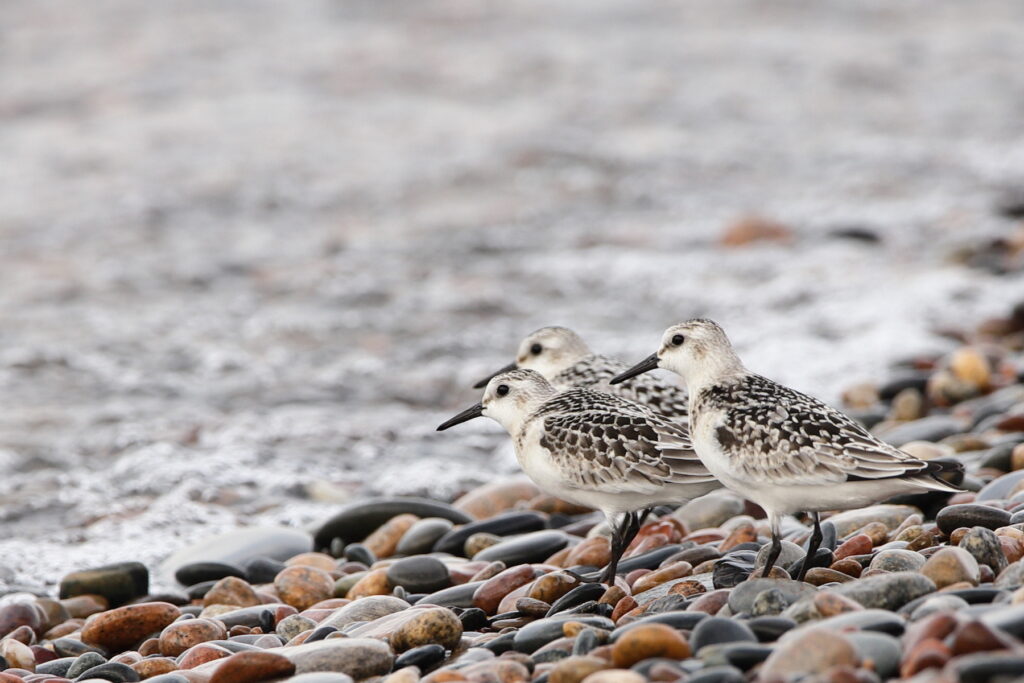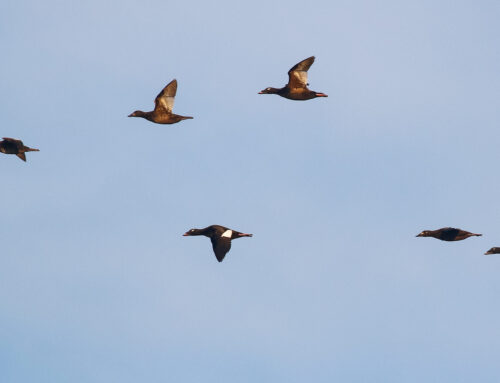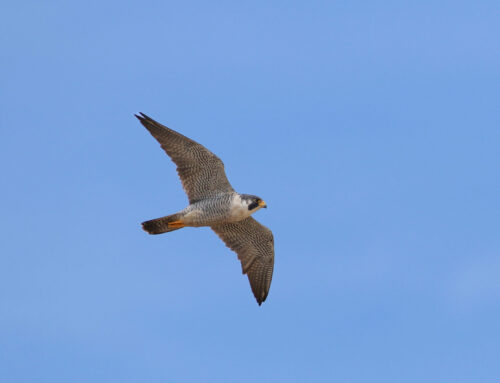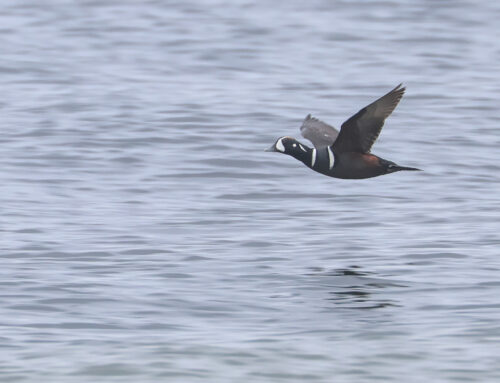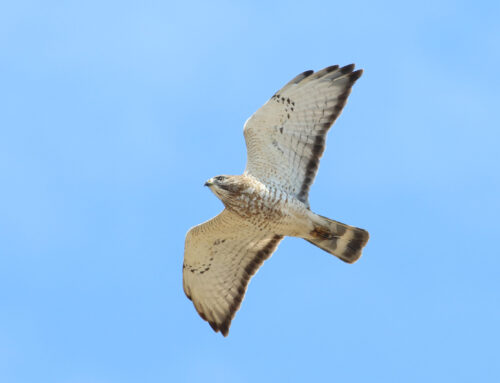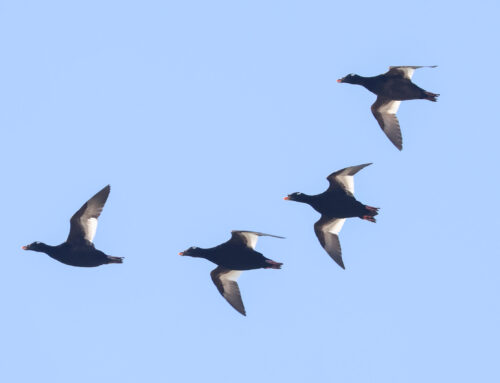May 22. Over the course of 8 hours, 655 Long-tailed Ducks (this spring’s peak flight, to date) rose, like apparitions, from The Gap. The Gap is terminology we use to point out waterbirds flying through the stretch of water bounded by Ile Parisienne and Ontario’s mainland — e.g., “there are two Red-throated Loons flying left through the gap!” But somehow, too, the gap represents tangible and not. When the Long-tailed Ducks disappeared through the gap last October, they wore winter: black and white, leaden water and ice. Now, in late May, they remerge again, wearing summer. Summer is the colors of the tundra they’re heading to: tawny grass; dark muck. (Check out Long-tailed Duck plumage here!) Watching birds enter the gap in fall, then emerge from the same spot in spring, symbolizes migration’s mystique. The glimpses we get are fleeting; there’s so much we don’t know. And I love the degree of wonder in the not-knowing.
May 22, continued. I heard, then saw, the first Whimbrel of the season. Heard, then saw, the first flock of molt-flight geese. These are signs of the end. We might actually think of geese as a sign of the beginning—they are, after all, a harbinger of spring. But at Whitefish Point they are a sign of the end, too. In late May, non-breeding Canada Geese form noisy flocks hundreds-strong and fly up to James Bay. There, they molt all their flight feathers and, while doing so, are unable to fly for several weeks. During this very vulnerable period, James Bay offers sufficient food; sufficient safety. When this goose flight passes Whitefish Point, the birds are already losing the flight feathers, and they look sort of ragged. Appropriate, for by this time I feel sort of ragged. The alarm gets earlier each day; the body protests harder; even when I lay down to sleep, lines of waterbirds still travel across the innards of my eyelids.
May 23. Black-bellied Plovers — stately, black and white, begin gracing our beach more frequently. They’re headed to the tundra too, and their call is beautifully melancholy, like my last steps out the boardwalk each morning: the sky is stunning, but the season is closing. And though I feel ragged and the body protests, I always wish things could just go on like this forever.
Peter Matthiessen, (author of The Snow Leopard and Shadow Country and so much more), writes, “The restlessness of shorebirds, their kinship with the distance and the swift seasons, the wistful signal of their voices down the long coastlines of the world make them, for me, the most affecting of wild creatures. I think of them as birds of the wind, of ‘wind birds.’”
The most affecting of wild creatures. The end of times would be sad, awfully sad, if they weren’t so full of shorebirds out here.
The morning is foggy — literally, metaphorically. The end of times usually is. Thoughts and air are heavy, the navigations murky. What else is out there, beyond perception? How to get there? Five Whimbrel drop into the tip pond, shrilling; thrilling. I stand up — called by a higher power, almost — to observe.
Shorebirds are strong fliers, migration champions. Many of them travel not only between seasons, but between hemispheres, too. They’re unthwarted by bad weather, confident in the Superior crossing. It takes quite foul conditions to ground a migrating shorebird flock at Whitefish Point. And this spring, the weather has been mild, my shorebird numbers correspondingly low. I’ve missed watching them.
But this foggy morning sets the shorebirds within reach of my mortal eyes, and flocks keep dropping from the sky. The numbers at the Point Pond build — 66 Whimbrel. 62 Dunlin, black bellies flashing against gray atmosphere. 10 White-rumped Sandpipers — a species that winters in Argentina, summers on the far northern limits of this continent. Our first-of-season Willet; 1 Stilt Sandpiper, to my knowledge, the first photographed in spring at Whitefish Point. My only human company consists of fellow migration counters. One of them, in fact, is visiting for his 40th year. We are bonded with quiet reverence; shared longing. We treat every scope scan as a homage to the travelers, appreciate the graceful lines, the long, pointed wings, that make possible these marathon migratory flights.
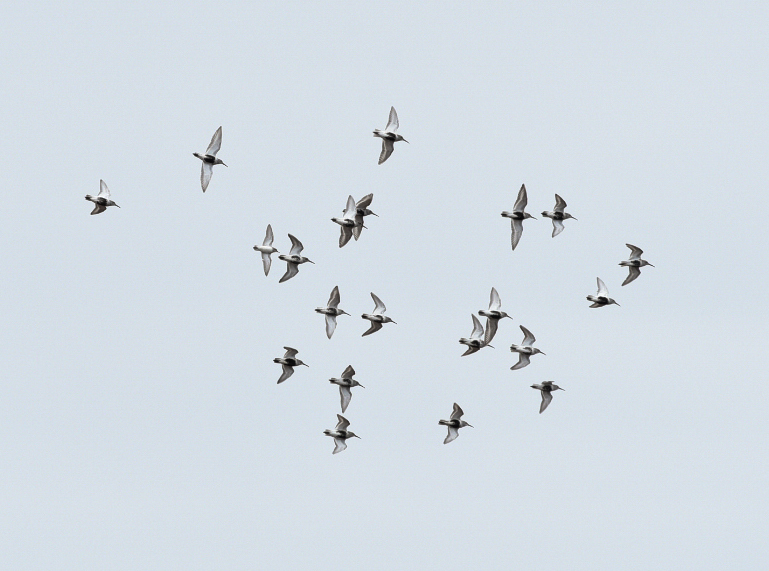
Dunlin and a “peep” flying over Whitefish Point. Photo by Alison Vilag
The shorebird flock builds, mills, waits for the conditions to change. There’s a lot I imagine I’ll never know about migration. But some things I do know. I know I’ll never tire of hearing a Whimbrel. I’ll know I’ll never take for granted the opportunity afforded by WPBO’s waterbird count to exist in a space of pointed observation. This week especially, I am convicted that we all need places like this that make us feel alive — that heighten our awareness of, then heal, our brokenness. If we all had that, how could the world not become a kinder place? Mary Oliver writes, “Attention is the beginning of devotion.” Joy Harjo says, “Let the earth stabilize your postcolonial insecure jitters…call upon the help of those who love you. These helpers take many forms: animal, element, bird…”
Within the last half-hour of the count, the fog lifts, and so do the shorebirds, restless to go. They bear north, they rise, they fall, they cry out. My heart does, too.
The restlessness of shorebirds, their kinship with the distance and the swift seasons, the wistful signal of their voices down the long coastlines of the world make them, for me, the most affecting of wild creatures.
The seasons are swift; the signs gesture towards the end of times; the fog gets heavy but the shorebirds offer lift.
Additional highlights at the waterbird count this week include 2 Hudsonian Godwits (May 24), a Eurasian Tree Sparrow (May 23), our largest spring flight, so far, of White-winged Scoter (320 on May 24), and a Pacific Loon seen by Alec Olivier while he counted for me on May 20.
As always, thank you for reading!
~ Alison Világ
2022 Spring Waterbird Counter
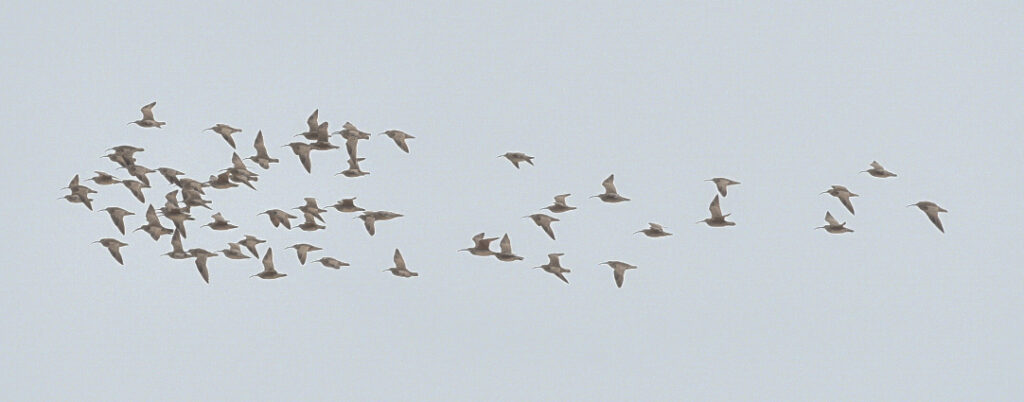
Whimbrel over Whitefish Point. Photo by Alison Vilag
Support WPBO’s Research During Birdathon on May 28
Our skilled team of bird counters and volunteers at Whitefish Point Bird Observatory will set out on a mission to count as many bird species as possible in one day on May 28, 2022, as part of an annual fundraising event supporting the amazing work happening at WPBO! In 2021, a whopping 152 species were counted and the event brought in $6,826.65! Let’s hope this year is just as successful.
This is where you come in! Because our work is 100% donor-funded, Birdathon provides all of our supporters with an opportunity to make a significant impact on our work by making a pledge or direct donation to Birdathon (even after the event). Any amount is helpful, but have some fun with it and consider letting your donation or pledge be inspired by a per-species amount.
Learn more about Birdathon and find links to donate at wpbo.org/birdathon.
Thank you so much to everyone who supports the work being done at WPBO!
